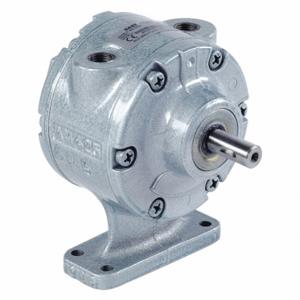Gast 4AM-FRV-13C air motor is ideal for efficiently transforming compressed air into mechanical force, providing adaptable power output. It is suitable for propelling machinery, stirring equipment and operating conveyors. This air motor is used in the manufacturing, automation and material handling industries, enhancing operational efficiency & productivity.
Features:
- This air motor is equipped with a 3 woodruff key for precise and reliable operation.
- It has a maximum air consumption of 78 cfm, making it an efficient choice for pneumatic applications.
- This air motor produces a maximum sound level of 87 dBA, which is suitable for industrial settings.
- It is designed to operate effectively at a maximum pressure of 7 bar, ensuring consistent performance.
- This air motor features a keyed output shaft, ensuring reliable power transmission.
- It is designed for foot mounting, providing stability and ease of installation.
Frequently Asked Questions:
Q. What are the factors to consider while choosing this air motor?
A.
- Power ratings
- Speed & air consumption
- Torque
- Mounting
- Port size
- Reversible rotation
- Noise level
Q. How does the reversible rotation feature work?
A. The reversible rotation feature allows the motor to change direction, providing versatility in applications. It's important for tasks where bidirectional motion is required.
Q. How do I maintain this air motor?
A.
- Perform regular inspections to detect wear, damage or loose components.
- Ensure the air supply is clean and dry by using filters and regulators to remove moisture and contaminants.
- Keep the air motor & its surroundings clean to prevent performance issues.
- Examine the condition of the vanes and replace them if worn or damaged.
- Monitor and maintain bearings, ensuring they are properly lubricated and replacing them as needed.
- Tighten any loose fasteners to maintain the air motor's stability.
- Maintain a detailed maintenance log to track activities and issues encountered.
- Provide ongoing training to personnel for safe operation and maintenance.
- Keep spare parts on hand to minimise downtime in case of component failure.
- Establish a regular maintenance schedule based on usage and environmental conditions.
- Inspect seals and gaskets for wear or damage and replace them as needed.
- Grease or lubricate components as required, such as bearings and moving parts.










